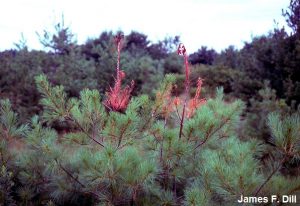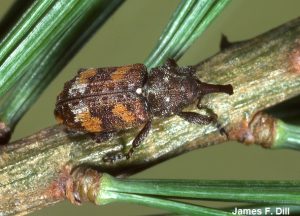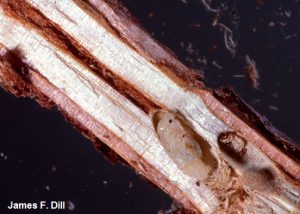White Pine Weevil
Pest Management Fact Sheet #5042
James F. Dill, Pest Management Specialist
Clay A. Kirby, Insect Diagnostician
Charles D. Armstrong, Cranberry Professional & Staff Entomologist
For information about UMaine Extension programs and resources, visit extension.umaine.edu.
Find more of our publications and books at extension.umaine.edu/publications/.
Description & Biology
The white pine weevil (Pissodes strobi), which kills the tops of conifers, is the most serious insect pest of white pine in Maine. The weevil also attacks Norway spruce, Colorado blue spruce, jack pine, red pine, Scotch pine, mugho pine and native spruces. On rare occasion, Douglas fir may also be attacked.
Adults become active in late March to mid-April and are found mating and feeding on the bark of terminal leaders. Eggs are laid from mid-April through June in the bark of the previous year’s leader. Upon hatching, grubs start tunneling downward under the bark. As they progress, the grubs gather in a feeding ring which effectively girdles the leader. Typically, the top 1½ to 2 feet of the main stem is killed, although severe attack may result in the loss of two to three years of growth. Weevils usually do not attack trees less than four or five years old, or less than three feet tall. Infested trees exhibit a wilting and browning leader, usually by July. Weevil-damaged trees eventually develop two leaders and a bushy appearance, thus reducing the value of ornamental trees. Trees are rarely killed by the weevils.
Mature grubs bore slightly into the woody stem where they form fibrous chip cells in which they pupate. By mid-July, some weevils have matured to the adult stage and emerge from the infested leaders. These new adults feed on the new shoots from late September to early October in the upper third of the crown. Usually by November, all weevils have entered the ground litter (often at the base of host trees) in order to overwinter.
- White Pine Weevil – damage
- White Pine Weevil – adult
- White Pine Weevil – pupa
Management
Preventive Pruning of Infested Leaders
At low infestation levels, prompt removal and burning of infested leaders before the weevils emerge reduces the chance of population buildup. Prune infested leaders at a point below the tunneling grubs that includes at least ‘some’ green bark at the base of the injury. Immediately burn cut leaders to destroy the larvae and/or pupae. Wilting leaders may be detected in June and July, but be sure to prune by mid-July to prevent emergence of adults.
Pruning infested leaders early in the season before completion of new shoot growth promotes establishment of a new dominant branch and correction of the stem form. Early pruning also prevents the grubs from penetrating the node of the first whorl of branches, reducing the amount of weevil-induced damage.
Cultural Control Methods
One alternative for preventive pruning is to avoid planting white pine or spruce in areas of high weevil hazard. Also, bear in mind that heavy clay soils and densely sodded fields might increase the chance of weevil attack.
Close spacing of trees in a plantation stimulates height growth and natural pruning of weevil-attacked trees. In addition, the physical characteristics of bark in dense or overtopped stands reduces the likelihood of adult weevil attack and subsequent brood development.
Partial shade helps protect the leaders from weevil attack by encouraging a bark thickness and a bark temperature that are less preferred by the weevils. Overtopping hardwoods or other conifer species help protect young pine and spruce when in the greatest need of protection. Overtopping tree density should provide 45% to 50% shade until the young trees are released when 16 to 18 feet high. However, the disadvantages of partial shade (reduced rate of growth and whipping injury) must be kept in mind.
Placing Tanglefoot® or similarly sticky substances on the wrapped leader, or wrapping tape around the leader (with the sticky side facing out), may also prevent infestation. However, never place sticky materials directly onto the tree surface itself, as injury to the tree may result. Instead, wrap something else around the tree first (aluminum foil or plastic wrap, for example) to hold the sticky material. During egg-laying season (mid-April through June), a nylon stocking can be secured over the leader as a physical barrier to the female white pine weevils.
Corrective Pruning
Corrective pruning of injured tops should remove all but a single, dominant shoot at the topmost healthy whorl. This promotes healing, resumption of vertical growth and straightening of the stem form. Corrective pruning may be postponed until the year after weevil injury to ensure that at least one lateral branch survives ice and snow damage or repeated weevil attacks the following year.
Special thanks to the Maine Forest Service for much of the content of this publication.
When Using Pesticides
ALWAYS FOLLOW LABEL DIRECTIONS!
Pest Management Unit
Cooperative Extension Diagnostic and Research Laboratory
17 Godfrey Drive, Orono, ME 04473
1.800.287.0279 (in Maine)
Information in this publication is provided purely for educational purposes. No responsibility is assumed for any problems associated with the use of products or services mentioned. No endorsement of products or companies is intended, nor is criticism of unnamed products or companies implied.
© 2016 | Reviewed/Revised: 2020, 2023
Call 800.287.0274 (in Maine), or 207.581.3188, for information on publications and program offerings from University of Maine Cooperative Extension, or visit extension.umaine.edu.
In complying with the letter and spirit of applicable laws and pursuing its own goals of diversity, the University of Maine System does not discriminate on the grounds of race, color, religion, sex, sexual orientation, transgender status, gender, gender identity or expression, ethnicity, national origin, citizenship status, familial status, ancestry, age, disability physical or mental, genetic information, or veterans or military status in employment, education, and all other programs and activities. The University provides reasonable accommodations to qualified individuals with disabilities upon request. The following person has been designated to handle inquiries regarding non-discrimination policies: Director of Equal Opportunity, 101 Boudreau Hall, University of Maine, Orono, ME 04469-5754, 207.581.1226, TTY 711 (Maine Relay System).




